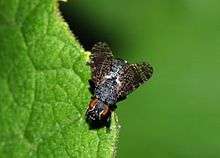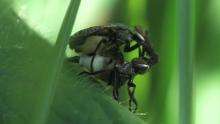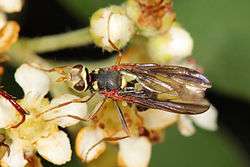Platystomatidae
| Platystomatidae | |
|---|---|
 | |
| Scientific classification | |
| Kingdom: | Animalia |
| Phylum: | Arthropoda |
| Class: | Insecta |
| Order: | Diptera |
| Superfamily: | Tephritoidea |
| Family: | Platystomatidae Schiner, 1862 |
| Subfamilia[1] | |
| |

The Platystomatidae (signal flies) are a distinctive family of flies (Diptera). Signal flies are worldwide in distribution, found in all the ecozones, but predominate in the tropics. It is one of the larger families of acalyptrate Diptera with around 1200 species in 119 genera.
Biology
Adults are found on tree trunks and foliage and are attracted to flowers, decaying fruit, excrement, sweat, and decomposing snails. Larvae are found on fresh and decaying vegetation, carrion, human corpses, and root nodules. Most larvae are either phytophagous (eating plant material) or saprophagous (eating decomposing organic matter). Some are predatory on other insects and others have been found in human lesions, while others are of minor agricultural significance.
Family description

For terms see Morphology of Diptera
Signal flies are very variable in external appearance, ranging from small (2.5 mm), slender species to large (20 mm), robust individuals, often with body colours having a distinctive metallic lustre and with face and wings usually patterned with dark spots or bands.The head is large. Frontal bristles on head are absent. Two orbital bristles are on the head. The frontal stripe is pubescent and the arista is more or less long and pubescent. The antenna1 grooves are deep and divided by a median keel. Radial vein 4+5 bears bristles. The costa is without interruptions and the anal cell is elongated, bordered on outer side by an arcuate or straight vein. The abdomen of male has five visible segments and the female has six.

_(18107194758).jpg)
Many bizarre forms of morphology occur in this family. Heads and legs (fore legs especially) may be oddly shaped, extended in various ways or with adornments, all of which serve to supplement agonistic behaviour. Such behaviour underlies social and sexual interaction between individuals of the same species of signal flies, first researched in Australian species of the genera Euprosopia image and Pogonortalis[2]
In males of Pogonortalis, the length and degree of development of hairs (setae) on the lower facial area, together with widening of the head, facilitates territorial dominance[3] by head-butting and rearing-up behaviours. Head-butting is taken to the extreme in the Australasian genus Achias,[4][5] in which species have the fronto-orbital plates expanded laterally to produce eyestalks.
Development of body structures is prevalent in the Afrotropical and Oriental subfamily Plastotephritinae,[6] including 9 different types of modification in 16 genera.[7]


Some species have prominent eyestalks also found in the family Diopsidae. In the Diopsidae, eyestalks develop through lateral development of the frontal plate, with the result that the antennae are situated on the stalk near the compound eye. The process of development in signal flies is different in that the fronto-orbital plates expanded laterally to produce eyestalks and consequently the antennae remain in a central position. This is an example of convergent evolution. The development of eyestalks reaches its extreme in the platystomatid species Achias rothschildi Austen, 1910 from New Guinea, pictured here in which males have an eye-span up to 55 mm.[8]
Families of acalyptrate flies exhibiting morphological development associated with agonistic behaviour include: Clusiidae, Diopsidae, Drosophilidae, Platystomatidae, Tephritidae, and Ulidiidae.
Other
Adults are sometimes amongst the most morphologically bizarre forms of all the Diptera.
References
- ↑ Biolib
- ↑ McAlpine, D.K.1973. Observations on sexual behaviour in some Australian Platystomatidae (Diptera, Schizophora). Records of the Australian Museum 29(1): 1-10.
- ↑ McAlpine, D.K.1975. Combat between males of Pogonortalis doclea (Diptera, Platystomatidae) and its relation to structural modification. Australian Entomological Magazine 2(5): 104-107.
- ↑ McAlpine, D.K.1979. Agonistic behavior in Achias australis (Diptera, Platystomatidae) and the significance of eyestalks. In: Blum, M. S. and Blum, N. A. (eds). Sexual selection and reproductive competition in insects. Academic Press, New York.
- ↑ McAlpine, D.K.1994. Review of the species of Achias (Diptera: Platystomatidae). Invert. Taxon. 8(1): 117-281.
- ↑ Whittington, A.E. 2003. Taxonomic revision of the Afrotropical Plastotephritinae (Diptera; Platystomatidae). Studia dipterologica Supplement 12: 1-300.
- ↑ Whittington, A.E. 2006. Extreme head morphology in Plastotephritinae (Diptera, Platystomatidae), with a proposition of classification of head structures in Acalyptrate Diptera. Instrumenta Biodiversitatis VII: 61-83.
- ↑ Arnauld, P. H. Jr. 1994. Frontispieces: Achias rothschildi Austen (Diptera: Platystomatidae). Myia 5: iv.
External links
![]() Data related to Platystomatidae at Wikispecies
Data related to Platystomatidae at Wikispecies
| Wikimedia Commons has media related to Platystomatidae. |
Species lists
- West Palaearctic including Russia
- Australasian/Oceanian
- Nearctic
- Japan
- World list
- Picture story about the biology of Platystoma seminationis
- EOL images
- Images representing Platystomatidae at Bold.